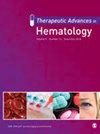更少更多吗?静脉注射免疫球蛋白治疗小儿免疫性血小板减少症
IF 3.1
3区 医学
Q2 HEMATOLOGY
引用次数: 0
摘要
目的:小儿免疫性血小板减少症(ITP)的治疗以出血风险为导向。静脉注射免疫球蛋白(IVIg)是新发小儿ITP的一线治疗方案之一。方法:这项回顾性队列研究纳入了 2010-2020 年间所有接受 IVIg 一线治疗的新确诊 ITP 住院患儿。我们比较了1克/千克和2克/千克两种常用IVIg剂量方案的安全性和有效性。结果:我们的队列中共纳入了 168 名患儿。82名儿童接受了每公斤1克的IVIg治疗,86名儿童接受了每公斤2克的IVIg治疗。两组在治疗后的持续反应(血小板计数> 20 × 109,> 14天)(分别为74.3% vs 76.7%,p = 0.72)和最大血小板计数(p = 0.44)方面没有差异。两组慢性 ITP 的比例没有差异(1 克/公斤组为 24.4%,2 克/公斤组为 17.4%;P = 0.34)。逻辑回归分析表明,IVIg 剂量对治疗失败和慢性 ITP 的发生没有影响。正如预期的那样,47.7%的不良事件发生在2克/千克组,32.9%发生在1克/千克组,具有边缘统计学意义(P = 0.06)。结论:在达到长期安全止血阈值方面,使用1克/千克IVIg方案对新诊断的小儿ITP进行初始治疗的效果可能与双倍剂量2克/千克相当,但不会影响慢性疾病的发生率。本文章由计算机程序翻译,如有差异,请以英文原文为准。
Is less more? Intravenous immunoglobulin for pediatric immune thrombocytopenia
Objectives:Treatment of pediatric immune thrombocytopenia (ITP) is guided by the risk of bleeding. Intravenous immunoglobulin (IVIg) is one of the first-line therapy options for new-onset pediatric ITP. However, the exact optimal dose of IVIg has not been determined.Methods:This retrospective cohort study included all hospitalized children with newly diagnosed ITP receiving IVIg as first-line therapy during 2010–2020. We compared the safety and efficacy of two common IVIg dose regimens, 1 and 2 g/kg. Outcomes were short and long-term treatment responses and adverse events to the different doses.Results:A total of 168 children were included in our cohort. Eighty-two children were treated with 1 g/kg of IVIg and 86 with 2 g/kg. There was no difference in sustained response (platelet count > 20 × 109 , > 14 days) between the groups (74.3% vs 76.7%, respectively, p = 0.72) and maximal platelet counts following treatment ( p = 0.44). No difference was found regarding the percentage of chronic ITP between the two groups (24.4% in the 1 g/kg group as compared to 17.4% in the 2 g/kg group; p = 0.34). Logistic regression analysis demonstrated there was no effect of the IVIg dose on treatment failure and development of chronic ITP. As anticipated, 47.7% of adverse events were in the 2 g/kg group and 32.9% in the 1 g/kg group, with borderline statistical significance ( p = 0.06).Conclusion:The initial treatment of newly diagnosed pediatric ITP using a 1 g/kg IVIg regimen may give comparable results to the double dose of 2 g/kg in attaining a prolonged safe hemostatic threshold, without impacting the incidence of chronic disease.
求助全文
通过发布文献求助,成功后即可免费获取论文全文。
去求助
来源期刊

Therapeutic Advances in Hematology
HEMATOLOGY-
CiteScore
4.30
自引率
0.00%
发文量
54
审稿时长
7 weeks
期刊介绍:
Therapeutic Advances in Hematology delivers the highest quality peer-reviewed articles, reviews, and scholarly comment on pioneering efforts and innovative studies across all areas of hematology. The journal has a strong clinical and pharmacological focus and is aimed at clinicians and researchers in hematology, providing a forum in print and online for publishing the highest quality articles in this area.
 求助内容:
求助内容: 应助结果提醒方式:
应助结果提醒方式:


